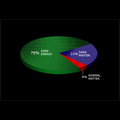CXC Home | Search | Help | Image Use Policy | Latest Images | Privacy | Accessibility | Glossary | Q&A
Q&A: Galaxies, Galaxy Clusters, AGN, and Quasars
Q:
According to a recent press release, Chandra provided detailed temperature maps for the gas of
galaxy clusters Abell 2390 and MS2137.3-2353 and allowed astronomers to
precisely determine the masses of the clusters. Most of the mass is in
the form of dark matter.
How does one determine the masses from the temperature maps?
A:
The Chandra press release on dark
energy:
http://chandra.harvard.edu/photo/2004/darkenergy/
states that measuring the ratio of the mass of the hot gas to the mass
of the dark matter in these large galaxy clusters is key to determining
whether our Universe is filled with "dark energy." The 2 measurements
needed are the mass profile of the hot gas and the total mass profile
of the cluster. Mass profiles can be thought of as maps of the mass
distribution.
Measuring the mass profile of the hot gas is relatively straightforward
since the emissivity of the x-ray emitting gas (the ratio of the
radiation emitted by the gas to that emitted by a black body at the
same temperature) is related to the density of the gas in a well
understood way. Measuring the total mass profile is harder and
requires a precise measurement of the temperature profile. Chandra is
ideally suited to such precise measurements due to its high resolution.
Obtaining the total mass profile from the temperature map is technical
- they use a combination of mathematical methods and computer programs.
Although it is not easy to describe, I will point you to their paper
in case you'd like to read through it. It is tough going but beginning
on page 4, section 2.3, there is a detailed description of their steps
and it might be nice to read through it and get an idea of how cutting
edge science is done:
http://xxx.lanl.gov/abs/astro-ph/0405340



